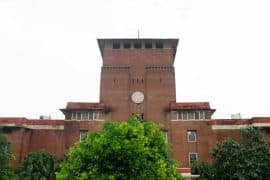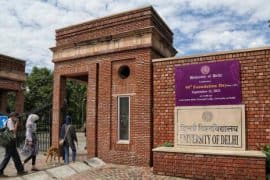In their recent memorandum to the Executive Council, Akhil Bharatiya Vidyarthi Parishad (ABVP) put forth a demand for the increment of 10% seats in all courses. Wandering over the possibilities, if they are feasible on the ground or is this just a demand to be said on paper?
In a memorandum asking for the reopening of campus, Akhil Bhartiya Vidyarthi Parishad (ABVP) included a demand to increase seats for all courses by 10%. With more and more students applying at the university every year, such a demand might look like a problem solver. But this ajooba can’t be done just like that (finger snapping). We wondered if this could really be possible, and there are various odds standing in the way of the expansion of DU.
Year after year, the cut-offs of the University of Delhi have been soaring high. This year as well 4,38,696 students have applied for the Undergraduate courses. Last year, in 2020 this number stood at 3,53,919. In the wake of a 20% increase in applicants, this year and a significant rise in this number each year might make this prospect appear wonderful. But after taking a closer look at the plethora of problems that the University has hurled upon itself it might appear as a not-so-wonderful idea.
As we know since last year, some colleges of the University have been struggling with a financial crisis. Lack of funds, non-payment of salaries, and problems faced by Ad-hoc teachers form the avalanche of problems that colleges have been facing lately. The introduction of new seats would put more pressure on the existing funds and infrastructure. This increment would also mean a change in the faculty and student ratio. According to a report in July, out of 1076 sanctioned posts, 846 teaching posts were lying vacant.
After the introduction of the EWS quota back in 2019, the varsity had various seats lying vacant in the category. Even in 2020, the EWS category had more vacant seats than in 2019. As reported by the Times of India, despite special drives and several cut-offs about 5.6% of seats of the EWS quota were still vacant. When DU hasn’t been able to work its way around an increment of seats within a quota, how will it be feasible for the entire university? Shouldn’t our first focus of attention be on filling all the seats in the existing seat count? About 1.5% of seats were left vacant under the OBC quota in 2020, 0.6% were vacant seats under the SC quota and even the ST seats saw the most vacancy in the year 2020.
Already under the plethora of problems, our beloved Delhi University has also implemented the New Education Policy starting from the year 2022. No talks around extra funds for the same have begun and teacher’s resistance against it continues. Under the Four Year Undergraduate Programme (FYUP), students will have the choice of studying at the university for the fourth year as well, irrespective of what number of students who opt for it, it will lay force on the existing resources. The varsity will have to be prepared to host students for one more year.
Professor Abha Habib, the Treasurer of DUTA said in a conversation with DU Beat,
“It is an insignificant demand, a long and due process is followed after sanctions from various committees and UGC. Instead of putting more load on the same University, more attention should be laid on state universities. Why should students be forced to move out of their states for education, premier institutes should be established within states or the existing ones should be improved. There is no scope for expansion in various colleges.”
Outstation students have to spend a lot on travel and stay for being in Delhi University. Costly PGs and barely cooked food are complementaries to the problems of staying outside your city or state. To understand such a plight DU Beat talked to a parent, Monika Sethi, mother of Ananya Sethi who is a second-year student.
“ Kids from tier-1 cities get to study in their own state but people from Uttar Pradesh and other states have to send their kids outside because of the dearth of opportunities here. The situation then becomes like there are two households to be taken care of including all the travel costs.”
Just to accommodate the growing number of students, the existing quality of education (which in itself consists of loads of unsolved problems) can’t be compromised. A lot of questions will have to be answered and a lot more issues to be resolved before the University can even think about the increment of seats.
Read Also: Why should DU increase its number of seats?
Feature Image Source: Times Of India
Kashish Shivani





Comments are closed.